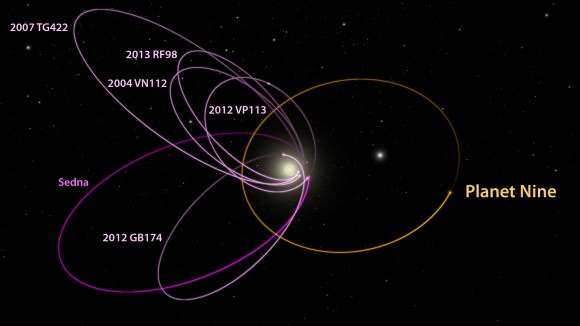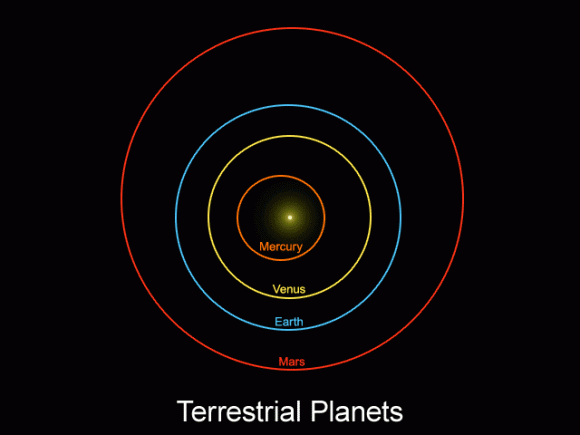In January of 2016, astronomers Mike Brown and Konstantin Batygin published the first evidence that there might be another planet in our Solar System. Known as “Planet 9”, this hypothetical body was believed to orbit at an extreme distance from our Sun. Since that time, multiple studies have been produced that have had tried to address the all-important question of where Planet 9 could have come from.
Whereas some studies have suggested that the planet moved to the edge of the Solar System after forming closer to the Sun, others have suggested that it might be an exoplanet that was captured early in the Solar System’s history. A recent study by a team of astronomers has cast doubt on this latter possibility, however, and indicates that Planet 9 likely formed closer to the Sun and migrated outward during its history.
Their study, titled “Was Planet 9 Captured in the Sun’s Natal Star-Forming Region?“, recently appeared in the Monthly Notices of the Royal Astronomical Society. The team was led by Dr. Richard Parker from the University of Sheffield’s Department of Physics and Astronomy, with colleagues from ETH Zurich. Together, they conducted simulations that cast doubt on the “capture” scenario.

Essentially, Planet 9 is believed to be at least ten times as massive as Earth and two to four times the size. It also believed to have a highly elliptical orbit around the Sun, at an average distance (semi-major axis) of approximately 700 AU and ranging from about 200 AU at perihelion to 1200 AU at aphelion. Last, but not least, scientists have estimated that Planet 9 takes between 10,000 and 20,000 years to complete a single orbit of the Sun.
Because of this, it appears unlikely that Planet 9 could have formed in its current location. Hence why astronomers have argued that it either formed closer to the Sun or was captured from another star system billions of years ago. As Dr. Parker explained in University of Sheffield press statement:
“We know that planetary systems form at the same time as stars, and when stars are very young they are usually found in groups where interactions between stellar siblings are common. Therefore, the environment where stars form directly affects planetary systems like our own, and is usually so densely populated that stars can capture other stars or planets.”

For the sake of their study, the team conducted simulations of the Solar System when it was still in its “nursery” phase – i.e. in the early process of formation. While interactions with other star systems (and their planets) are known to be common in this period, the team found that even where conditions were optimized for the sake of capturing free-floating planets, the odds of Planet 9 being captured were quite low.
Overall, their simulations indicated that with an orbit like that of Planet 9, only 5 to 10 planets out of 10,000 would be captured when the Solar System was still young. In short, the likelihood that Planet 9 could have been booted out of another star system and captured by our Sun was a paltry 1 out of a 1,000 to 2,000. Not exactly betting odds! As Dr. Parker summarized:
“In this work, we have shown that – although capture is common – ensnaring planets onto the postulated orbit of Planet 9 is very improbable. We’re not ruling out the idea of Planet 9, but instead we’re saying that it must have formed around the sun, rather than captured from another planetary system.”
If Planet 9 was not captured, then there remains only one possibility: ut formed closer to our Sun and gradually migrated beyond the orbit of Neptune, reaching distances occupied only by the most extreme Kuiper Belt Objects. And while the hunt of this elusive and mysterious planet is ongoing, any research which places additional constraints on its characteristics and origin are extremely useful.
By ruling out different scenarios in which the planet formed, researchers are also raising new questions about the history and evolution of our Solar System. From when did all the planets we know come from? Did they form in their current orbits, or did migration play a role? These and other questions are sure to be raised and addressed as we close in on Planet 9.
Further Reading: University of Sheffield, MNRAS


From the information given in the article regarding the size and mass of Planet 9 (10 times the Earth mass and 2 to 4 times the Earth’s size), it would appear that Planet 9’s density ranges from 0.16 to 1.25 times the density of Earth. In other words, Planet 9 could be anything from an icy planet to a rocky planet like Earth. To the extent that it’s density is on the higher side of that range, it may have formed within the inner Solar System, inside the orbit of Jupiter. This raises the possibility that it’s current location might have resulted from gravitational interactions with the Jovian planet.
Very interesting article.
Parker’s paper discusses the capture of free floating planets. There is another way of capturing a planet from outside the Solar System: capturing a planet that is in a distant orbit around another star: Is there an exoplanet in the Solar System? https://arxiv.org/abs/1603.07247 They found the odds of capturing a planet in an orbit like that proposed for Planet Nine of up to 1%.
It is not easy to capture planet by natural way. We but have (on orbits around our planet) many satellites. Were those ones captured?_It look so (from my calculations, computer simulations,…based on ancient sources), that there are two undiscovered massive planets in our Solar system. One planet is cca on orbit which Mike Brown with Konstantin Batygin proposed too, but more massive. The second one on more prolongated orbit with variable period 900-2200 years,..
It is much more probable that Planet 9 was formed in our Solar system,… So, where it was formed? P9 was formed where it cca is now, or somewhere among our planets? There is Sumerian myth Enuma Elish,..which says, that planets Maldek, Tiamat,…where destroyed during wars, mutual collisions,…(some rests should be asteroids,,,among Mars and Jupiter,…our Earth).. Orbital speeds of Maldek, Tiamat for such orbits so had to been around 20km/s. If their satellites during collisions abandoned mother planets,..so their orbital speeds around their mother planets had to been around 10km/s for to got on positions of our planetoids with prolongates orbits behind Pluto. How massive so was Maldek or Tiamat? Planet which lost its moons had to be cca Neptune,Jupiter or more massive like planet. Only such heavy planets could have regular spherical (10km/s or more speedy) moons,…